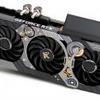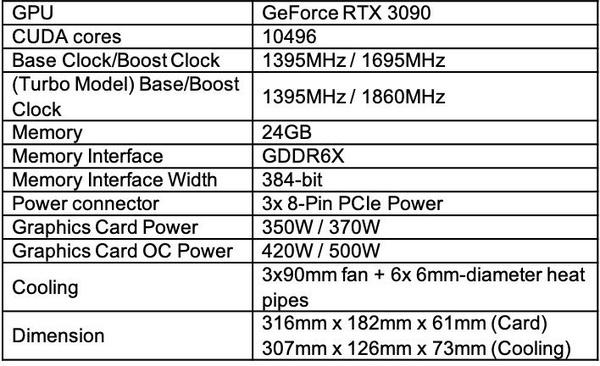Introduction
Colorful GeForce RTX 3090 iGame KUDAN review
Colorful offers a super over-engineered GeForce RTX 3090, in the form of the iGame KUDAN (a spirit) edition graphics card. Tweaked to the max, huge power budget, and a card that remains silent for a product in this enthusiast range, thanks to a combo of air and liquid cooling that is. Combine that with 24 GB of the fastest GDDR6X memory your money can get you. What will beef up 10469 shader core powered product offer you?
Yes, every now and then a company wants to make a statement, spread no expense, and in a limited edition meet the new iGame KUDAN. Now let me warn you immediately, you can't find or purchase this graphics card really, with 1000 pieces made it was designed to be a showcase. And Admittedly, Colorful might have fabricated the most gorgeous-looking RTX 3090 of the year. Hybrid air cooling, exquisite quick coupling liquid cooling, a full-color LCD panel allowing you to read out the GPU, and overall an experience that will make you drool a little.
But hey, now let's stick to what we have on deck; we review and benchmark the new premium flagship graphics card. All hail the might and awe that is the GeForce RTX 3090. Armed with a shader core count that will make at least one of your eyebrows frown with a nearly nauseating 24 GB of blazingly fast GDDR6X graphics memory. The GeForce RTX 3080 already is a smoking hot product, but of course, but NVIDIA is NVIDIA and decided to stretch their legs a little more. One thing that needs to be stated, though, the product shown today is all about Ultra HD and higher resolutions. It is an RTX Titan replacement or successor, I should say. I write all this before testing the product, but I already understand that it will be hard to show where this product will make real sense. For me, the good news is, at least, a product doesn't have to make sense to be appreciable. I mean, you like Ferrari as well, eh? (albeit right now, that probably that is not the best example). Well, Tesla maybe .. a model S is out of range for many, but man, they drive nice, accelerate fast, and you get that feeling you're driving something from Star Trek. That said, in that realm, we think the RTX 3090 will position itself in its own niche. It was 2017 when Ampere as a GPU architecture surfaced on the web, and, up-to earlier this year, NVIDIA had not listed this name in any of its roadmaps on the consumer side. It was with military-level secrecy that the Ampere consumer part was developed. Ampere, of course, is the base unit of electric current in the international system of units. But the GPU is named after André-Marie Ampère, a French mathematician and physicist, considered the father of electrodynamics. NVIDIA has a track record of naming their GPU architectures after mathematicians and physicists or figures from closely related fields, of naming a few; Pascal, Fermi, Kepler, Maxwell, and, more recently, Turing. While it was no secret that the new GPUs would be based on Ampere, we've seen much discussion about fabrication nodes, architecture, and specifications. Still, everybody seems to have forgotten that Ampere already launched earlier this year for the HPC market. The first product based on Ampere was the NVIDIA Tesla A100, outfitted with a GA100 Ampere GPU based on 7nm fabricated at TSMC; that product holds 54 billion transistors 6912 Shader cores. On September 1st of 2020, NVIDIA announced three initial Ampere graphics cards in its first launch wave. A week before announcements, specifications of the GeForce RTX 3080 and 3090 took a twist; the shader core count mysteriously doubled up from what everybody expected. The GPUs are fabricated on an 8nm node derived from Samsung. This process further develops Samsung's 10nm process; no EUV is applied in production just yet. The first wave of announcements would see the GeForce RTX 3080 and 3090 being released first, and, as a bit of a surprise, the GeForce RTX 3070 would be arriving in roughly the same timeframe as well. The initial launch of Ampere for consumers entails the GeForce RTX 3070 8GB GDDR6, RTX 3080 10GB GDDR6X, and what we test today, the 24GB GDDR6X based premium flagship, the mighty mo, the GeForce RTX 3090. The lineup nearly doubles Raytracing performance with Gen2 ray-tracing cores and 3rd iteration Tensor cores. These cards will all be PCIe 4.0 interface compatible and offer HDMI 2.1 and DisplayPort 1.4a. Most importantly, it is that outrageous shader processor count (referred to as CUDA cores by NVIDIA), passing the 10K marker; nobody.. not even us, saw that one coming.
The NVIDIA GA102 GPU is used initially for two products, the GeForce RTX 3080 and 3090 graphics cards. And it is one big GPU die and product overall alright; the 3090's GA102-300-A1 GPU is armed with 10.496 Shader processors and 28 billion transistors. And no, that's not even the fully unlocked product. FYI: the GeForce RTX 3080 is listed as having 8.704 Shader cores, and the GeForce RTX 3070 (GA104) will bring 5.888 Shader cores to the table. In this review, we'll check out the mother of them all, the GeForce RTX 3090, paired with 24GB of all GDDR6X graphics memory, 24 GB, and 10K+ Shader cores.
Colorful iGAME GeForce RTX 3090 KUDAN 24GB
The iGAME Kudan graphics cards are always produced in limited amounts and are not easy to obtain through commercial etailers, especially in foreign countries. Of course, the GeForce RTX 3090 KUDAN has been fitted with maximum enabled NVIDIA GA102-300 GPU; it has a hefty 10.469 Shader cores activated and is paired with 24 GB of all-new GDDR6X graphics memory.
Colorful equipped the card with a semi-passive design; three fans start to spin and cool everything but the GPU, as that part is liquid-cooled. The card is beefed up to the extreme. It has a secondary BIOS that offers best performance. Albeit both BIOS modes offer the same performance you'll get a bit more power leash. Colorful increased the power usage allowance as well as the turbo clock frequency. Colorful is reusing its RTX 3090 Vulcan board design for KUDAN This card has a clock speed of 1860 MHz, the fastest on the market. The memory runs at 19.5 Gbps effective. The cards have been fitted with 3x 8 (6+2) pins to amp up hefty values, possibly creating challenges with some power supplies cables (and power). So it would be best if you had at least a proper 850 Watt PSU for this graphics card. KUDAN is shipped with the same sized screen of 90° as their RTX 3090 iGAME Vulcan. This is probably due to the fact that the Graphics Card has a hybrid cooling system that requires more space. The cooling is interesting, included is a 240mm radiator with preinstalled pump. Two sleeved thick tubes can be attached to the graphics card through quick-coupling connectors. This is the interesting part, this is not required as the graphics card can work without a liquid loop attached also.
With up to 420W power allowance in the OC mode (this BIOS mode is enabled with the press of a button on the side), the KUDAN design may be manually controlled up to 500W, and that will show in overclocking mostly. Three 8-pin power connections feed the 14+8+4 VRM configuration on the graphics card. Colorful announced that its RTX 3090 KUDAN production will be limited to 1000 units and they will cost a mind-boggling 4999 USD each. I'll leave that to sink in for a minute with the comment, this product series is a marketing showcase, of course (but still fun to test!). You'll receive a free bracket to support the weight of the card should you want/need that, a free power bank and it's delivered in a suit/flight case—all that with exquisite looks, of course. But hey, judge for yourself. Let's start up this review, shall we?



